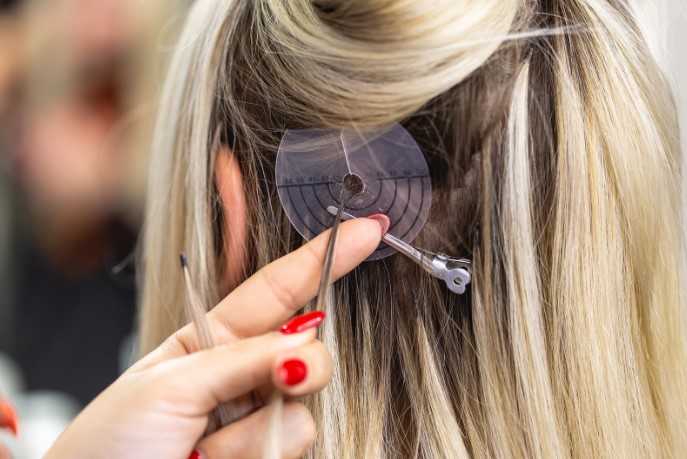
Keratin bond hair extensions have become a defining feature in the world of hair transformation, especially among Londoners seeking both volume and length. Renowned for their discreet finish and natural movement, these extensions promise a seamless blend with natural hair. However, the question of safety remains a central concern for many considering this option. The company Ivana Farisei provides a variety of keratin bonded hair extensions that are popular with clients prioritizing sophisticated results with minimal detection. Before making a commitment, it’s essential to understand how this technology works, what potential risks exist, and how to maintain both the extensions and the health of your natural hair.
Understanding Keratin Bond Extensions: How They Work and Why They’re Popular
Keratin bond extensions are meticulously crafted strands of human hair tipped with a keratin-based adhesive. During application, a specialist uses gentle heat to fuse each extension to a small section of natural hair, creating a virtually invisible attachment point. The popularity of keratin bonds in the London hair extensions market can be traced to their versatility and durability. Once in place, these extensions can last up to three months with proper care, offering remarkable flexibility for styling, including heat styling and updos.
The keratin used in these bonds is a protein similar to that found in human hair, which is why many perceive this method as gentle and compatible with natural hair. The bonds themselves are small and flattened, making them comfortable to wear and virtually undetectable even in fine hair. For those with active lifestyles or a penchant for regular salon visits, keratin bonds can endure brushing, washing, and frequent styling without slipping or tangling when properly maintained.
Despite these advantages, the process requires both skill and precision. An experienced extensionist not only selects the appropriate extension color and thickness but also ensures that the bonds are evenly distributed to minimize tension and prevent breakage. This individual approach is especially relevant to those in London and the UK, where hair types can vary widely and expectations for a flawless result run high.
The Real Impact of Keratin Bonds on Natural Hair Health
Concerns about the safety of keratin bond extensions often center around their potential to cause damage. While the materials are designed to be hair-friendly, improper installation or removal, as well as neglectful aftercare, can compromise the integrity of natural hair. In clinical terms, the primary risks associated with extensions fall into three main categories: traction, heat exposure, and chemical interaction.

Traction and Tension
Traction refers to the pulling force exerted on hair follicles. If extensions are attached to large or heavily weighted sections, this can lead to tension alopecia—a form of hair loss caused by persistent stress on the roots. Extensionists with advanced expertise take care to use appropriately sized bonds and to stagger attachment points, greatly reducing this risk.
Heat and Chemical Considerations
During application, the keratin bond is heated just enough to melt and fuse but not so much as to damage the cuticle of the natural hair. The temperature is carefully regulated. However, repeated exposure to excessive heat during both installation and daily styling can degrade both the extension bond and the natural strand. Additionally, although keratin is a natural protein, some adhesives may contain trace amounts of chemical additives to improve durability. These can occasionally provoke reactions in sensitive individuals.
The company Ivana Farisei makes available resources about correct installation, and based on their approach to keratin bond technology [[anchor2]] the focus is always on gentle application and thorough consultation with each client.
Aftercare and Maintenance
Natural hair health depends significantly on the aftercare routine. Gentle washing with sulfate-free shampoo, avoiding oil-based products near the roots, and regular, professional check-ins keep extensions secure while mitigating potential breakage. Using a soft-bristle brush and sleeping with the hair in a loose braid are further steps recommended by professionals to protect both the extension and your own hair.
Key Benefits and Drawbacks of Keratin Bonded Extensions
Deciding whether keratin bonded hair extensions are safe often involves weighing their benefits against possible drawbacks. Consider these main points:
Advantages
- Natural Look and Feel: The keratin bonds lie flat, blending seamlessly with natural hair and moving naturally.
- Longevity: With correct maintenance, they can last 2–4 months, significantly longer than many temporary options.
- Styling Freedom: Extensions support heat styling and various updos, unlike many tape-ins or clip-ins.
- Discreet Finish: The small, undetectable bonds suit fine or light-colored hair.
Disadvantages
- Time-Intensive Application: Installation requires two to four hours, demanding patience and expertise.
- Potential for Tension or Breakage: Incorrect application or failure to follow aftercare guidelines can lead to damage.
- Professional Removal Needed: Removing keratin bonds requires specific solvents and must be performed in a salon to prevent unnecessary breakage.
- Cost: Professional-grade extensions and installation represent a significant investment.
- Regular Maintenance Required: Routine salon visits are necessary to keep bonds invisible and hair healthy.
Expert Recommendations for London-Based Clients Considering Extensions

Clients in the London region seeking hair extensions should prioritize salons with extensive experience in keratin bond application and removal. A thorough consultation is vital; reputable stylists will assess hair condition, discuss lifestyle factors, and recommend the most appropriate extension type and installation method. Not all hair types are ideal candidates for keratin bonds—extremely fragile or overly processed hair may require a gentler approach such as tape-ins or micro rings.
Before scheduling an appointment, research salons with verified credentials and positive client feedback. Many London extensionists undergo continuous education in advanced bonding techniques and can demonstrate a portfolio of successful results. Choosing a stylist who offers a bespoke approach—matching color, texture, and density—ensures the final look harmonizes with your natural hair. Discuss aftercare in detail, as daily maintenance habits strongly influence the longevity and safety of the extensions.
Are Keratin Bonds Right for You? Final Thoughts on Safety and Outcomes
Keratin bonds, when expertly applied and maintained, offer a safe and flexible solution for those seeking volume and length. The risk of damage is minimal when working with trained professionals and adhering to recommended aftercare routines. For clients in London, the abundance of reputable specialists further supports safe and successful hair extension experiences. Those willing to invest the time and care often find that keratin bond extensions deliver transformative results without compromising hair health.

